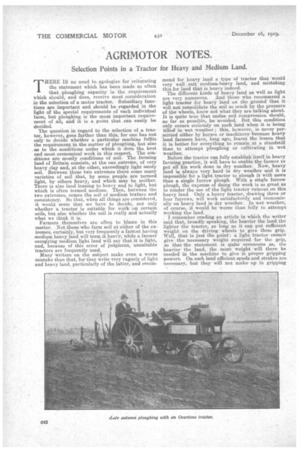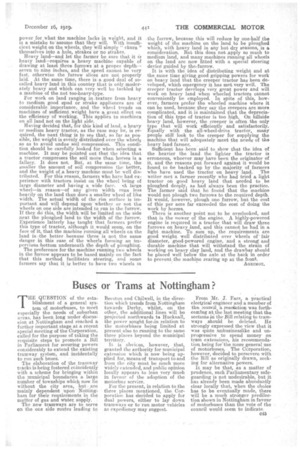AGRIMOTOR NOTES.
Page 22

Page 23

If you've noticed an error in this article please click here to report it so we can fix it.
Selection Points in a Tractor for Heavy and Medium Land.
THERE IS no need to apologize for reiterating the statement which has been made so often that ploughing capacity is the requirement which should, and does, receive most consideration in the selection of a motor tractor. Subsidiary functions axe important and should be regarded in the light of the special requirements of each individual farm, but ploughing is the most important requirement of all, and. it is a point that can easily be decided.
The question in regard to the selection of a tractor, however, goes further than this, for one has not only to decide whether a. particular machine fulfils the requirement in the matter of ploughing, but also as to the conditions under which it does the best and most economical work in this respect. The conditions are mostly conditions of sail. The farming land of Britain consists, at the one extreme, of very heavy clay and, at the other, exceedingly light sandy soil. Between these two extremes there come many varieties of soil that, by some people are termed light, by others heavy; and which may be neither. There is also land leaning to heavy and to light, but which is often termed medium. Then, between the two extremes, comes the soil of medium texture and consistency. So that, when all things are considered, it would seem that we have to decide, not only whether a tractor i5 suitable for work on certain soils, but also whether the soil is really and actually what we think it is.
Farmers themselves are often to blame in this matter. Not those who farm soil at either of the extremes; certainly, but very frequently a farmer having medium heavy land will term it heavy, while a farmer occupying medium light land will say that it is light, and, because of this error of judgment, unsuitable tractors are frequently used. Many writers on the subject make even a worse mistake than that, for they write very vaguely of light and heavy land, particularly of the latter, and recom
mend for heavy land a type of tractor that would very well suit medium-heavy land, and mistaking this for land that is heavy indeed.
The different kinds of heavy land as well as light are very numerous. And those who recommend a. light tractor for heavy land on the ground that it will not consolidate the soil so much by the pressure of the wheels, know not what they are talking about. It is quite true that undue soil compression should, as far as possible, be avoided. But this condition only occurs seriously on such land when it is being tilled in wet 'weather; this, however, is never permitted either by horses or machinery because heavy land farmers have, long ago, learnt the lesson that it is better for everything to remain at a standstill than to attempt ploughing or cultivating in wet weather.
Before the tractor can fully establish itself in heavy farming practice, it will have to enable the farmer to get all his work done in dry weather. Now, heavy land is always very hard in dry weather and it is impossible for a light tractor to plough it with more than a single furrow plough. With a single furrow plough, the expense of doing the work is so great as to render the use of the light tractor ruinous on this heavy land. Only a heavy tractor, drawing three or four furrows, will work satisfactorily and economically on heavy land in dry weather. In wet weather, of course, it would be worse than folly to attempt working the land. I remember reading an article in which the writer said that, broadly speaking, the heavier the land the lighter the tractor, so long as it can put sufficient weight on the driving wheels to give them grip. Well, that is just the point: a light tractor cannot give the necessary weight required for the grip, so that the statement is quite erroneous as, the heavier the land, the more weight will there be needed in the machine to give it proper gripping powers. On such land efficient spuds and strakes are necessary, but they will not make up in gripping power for ,what the machine lacks in weight, and it is a mistake to assume that they will. With insufficient weight on the wheels, they will simply " churn " themselves into a hole, strakes Or no straies.
Heavy land—and let the farmer be sure that it is heavy land—requires a heavy machine capable of drawing at least three furrows at a proper depth— seven to nine inches, and the speed cannot be very fast, otherwise the furrow slices are not properly laid. At the same time, there is a good deal of socalled heavy land in this country that is only moderately heavy and which can very, well he tackled by a machine of the not too-heavy-type. For work on land ranging in.. texture from heavy to medium a good spud or strake appliances are of considerable, importance, and the wheel treads on machines of sufficient weight have a great effect on the efficiency of' working. This applies to machines. on all land not on the light side. Having decided that, for this kind of land, a heavy or medium heavy tractor, as the ease may be, is required, the next thing is to see that, so far as possible, the weight is evenly, distributed over the wheels so as to avoid undue soil 'compression. This condition should be carefully looked for when selecting a machine. It may be pointed out that the idea that a tractor compresses the soil more than horses is a fallacy. It does not. But, at the same time, the smaller the amount of soil compression the better, and the Weight of a heavy machine must he well distributed. For this reason, farmers who have had experience with tractors insist on the wheel being of large diameter and having a wide face. ea. large wheel—in reason—of any given width runs less heavily on the land than does a smaller wheel of like width. The actual width of the rim surface is important and will depend upon. whether, or not the wheels on one side are intended, to run in the furrow. If they eld this, the width will be limited on the side next the ploughed land to the .width of the furrow. ExPerience latterly has taught. that farmers prefer this type of tractor, although it would seem, on the face of it, that the machine running all wheels en the land is the better because there is not the same danger in this ease of the wheels forming an impervious bottom underneath the depth of ploughing.
The preference for the machine running two wheels in the furrow appears to be based mainly on the fact that this method facilitates steering, and some farmers Say that it is better to have two wheels in the furrow, because this will reduce by one-half the weight of the machine on the land to be ploughed which, with heavy land in any but dry seasons, is a consideration. But this does not „apply so much to medium land, and many machines running all wheels on the land are now fitted with a special steering device' guided by the4urrow.
It is with the idea of distributing weight and at the same time giving good gripping powers for work on heavy land that the creeper tractor has been developed, which emergency it has met very well. The creeper tractor develops very great power and will work on heavy land when wheeled tractors cannot conveniently be employed. In spite of this however, farmers prefer the wheeled machine where it can be used, because they say the creepers are more complicated, and it is maintained that the depreciation of this type of tractor is too high. On hillside heavy land, however, the creeper is often the only type that will work efficiently and satisfactorily. Equally with the all-wheei-drive tractor, many people still look to the creeper for supplying the machine that will adequately meet the needs of the heavy land farmer. _
Sufficient has been said to show that the idea of the heavier the land the lighter the tractor is erroneous, whoever may have been the originator of it, and the reasons put forward against it would be found to 'be backed up by the majority of farmers who have used the tractor on heavy land. The writer meta farmer recently 'who had tried a light tractor on good heavy land that needed to be ploughed deeply, as had always been the practice. The farmer said that he found that the machine would not plough two furrows to the required depth. It would, however, plough one furrow, but the cost of this per acre far exceeded the cost of doing the work by horses.
There is another point not to be overlooked, and that is the flower of the engine. A highly-powered engine is required in a tractor that will draw three furrows on heavy land, and this cannot be had it a light machine. To .sum up, the .requirements are good weight well distributed over wheels of fair diameter, good-powered engine, and a strong and durable machine that will withstand the strain of working on heavy clay land, and the drawbar should be placed well below the axle at the beak in order to prevent, the machine rearing up at the float. AcatimoT.


























